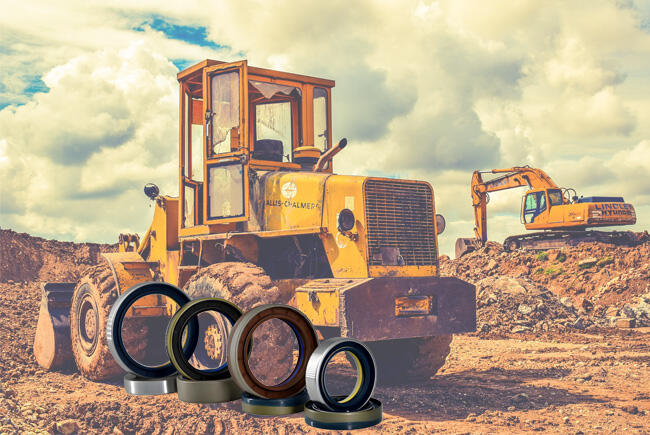On construction sites, it's not the steel plates that truly bear the brunt of bulldozers' wear and tear, but the seals that silently operate. Hydraulic cylinders repeatedly rise and fall, travel motors maintain high temperatures, and transmission and engine shafts rotate at high speeds. Mud, dust, and temperature differentials put every seal to the test. Choosing the right seal structure and material isn't a matter of "stockpiling" but rather a trade-off based on the operating conditions.
Common Types and Key Usages
O-rings: Suitable for pumps, valves, flanges, and static seals. They can also be used with retaining rings for pistons and rods. Nitrile (NBR) and fluororubber (FKM) are common. In hydraulic cylinders, they can be used with support rings to handle system pressures of 25–40 MPa and short-term shocks.
· X-rings: With an X-shaped cross section and double sealing edges to suppress rolling and twisting, they are suitable for frequently reciprocating, short-stroke components such as control valve cores and pilot circuits.
· U-cups/PU: The primary dynamic seal, covering the piston and rod. Most are polyurethane or polytetrafluoroethylene (PTFE) + elastomer combinations, offering low friction, wear resistance, bidirectional sealing, and stable handling of lateral loads.
· V-Packings: Multiple stacked packings are suitable for large diameters, high pressures, and slight eccentricity. They are commonly used in retrofits of bulldozer lift cylinders and ripper cylinders for older equipment.
· Dust/scraper rings: Installed outward on the cylinder end, they serve as the first line of defense against mud, sand, and moisture. Polyurethane or metal-framed structures offer greater deformation resistance, while double-lip types can also scrape away trace oil films.
· Rotary shaft oil seals (lip seals): Used on engine crankshafts, transmission input/output shafts, motors, and pump shaft ends. Primarily made of nitrile rubber (NBR) or fluororubber (FKM), PTFE lips may be added as needed to reduce friction and heat generation.
· Swing/travel motor rotary seals: Consider backpressure and temperature rise. Spring-energized PTFE + stainless steel springs or metal-shell reinforced types offer a balanced balance between pressure resistance and concentricity. Matching Materials, Structures, and Operating Conditions
Nitrile (NBR): Resistant to mineral oils and fuels, operating at temperatures down to -40°C, offering a high cost-effectiveness ratio and suitable for most hydraulic and transmission oil environments.
Fluorocarbon (FKM): Suitable for high temperatures and chemical media, providing enhanced stability in areas near heat sources in engines and transmissions.
PU: Highly elastic and tear-resistant, a top choice for dust protection and U-cups, with reliable resistance to particle wear.
PTFE: Extremely low friction, anti-stick-slip, suitable for high-speed and low-friction applications; often used with elastomers or springs to provide preload.
Support Rings/Retaining Rings: Resist extrusion, ensuring O-rings are protected from shearing at temperatures exceeding 25 MPa.
Applicable Applications
· Construction Machinery Assembly and Maintenance: Main hydraulic systems, working device cylinders, steering and travel motors.
· Hydraulic System Integrators and Repairers: Pump, valve, and cylinder assembly and overhaul.
· Engine/Transmission Repair Shop: Crankshaft, camshaft, and input/output shaft oil seal replacement.
· Chassis and Slewing Bearing Supplier: Track drive, slewing seal, and lubrication management.
· Mining/Metallurgy/Chemical Site Equipment Department: Seal adaptation and spare parts management for heavy dust and corrosive media.

Some Tips
· Delivery and Stocking: It is recommended to stratify popular specifications by "rod diameter/cylinder diameter × common pressure level"; oil seals can be grouped by shaft diameter/speed/temperature range to shorten repair wait times.
· Replacement Feasibility: Non-original parts can be used, but they must match the size, material, pressure, and lip structure. For older cylinder blocks, it is recommended to simultaneously inspect groove wear and rod surface hardness to avoid "new parts with old problems."
· Lifespan and Maintenance: Seal inspections are generally performed every 1500–2500 hours. In heavy dust and high-impact construction sites, inspections should be performed earlier. Key cylinders can be monitored for leakage and temperature rise for preventative replacement.
· Common Failures: Extrusion, scratches, lip carbonization, and dry friction at the edges are typical causes of heat and chipping. Solutions include optimizing material combinations, adding support rings, and improving lubrication and surface quality.
· Proofing and Coding: Batch coding, neutral packaging, and part number mapping are available to facilitate channel and after-sales tracking. It is recommended to retain photos of the old parts and groove dimensions to increase the success rate of re-fitting.
Seals are not a single component, but a system. Bulldozer seal selection should be considered comprehensively based on operating conditions, structure, materials, and processing details. In the cylinder, a combination seal and dust seal stabilize pressure and control contamination. On the power transmission end, a suitable lip oil seal balances temperature and speed. Combined with appropriate inventory and preventative maintenance, the risk of downtime and leakage costs can be minimized.
 Hot News
Hot News